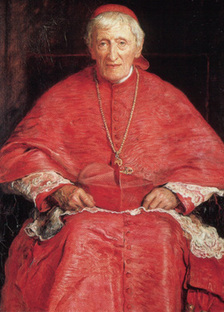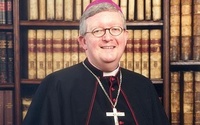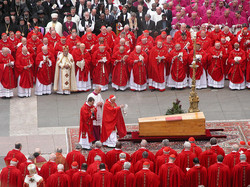 Just days ahead of Pope John Paul II’s beatification on May 1st –the first time in 11 centuries that a successor beatifies his predecessor– the former vicar for Rome, Cardinal Camillo Ruini, speaks about the letter he received as the conclave was about to open that was to elect Joseph Cardinal Ratzinger, now Pope Benedixt XVI, by which several cardinals asked for John Paul’s beatification. Read the La Stampa story…
Just days ahead of Pope John Paul II’s beatification on May 1st –the first time in 11 centuries that a successor beatifies his predecessor– the former vicar for Rome, Cardinal Camillo Ruini, speaks about the letter he received as the conclave was about to open that was to elect Joseph Cardinal Ratzinger, now Pope Benedixt XVI, by which several cardinals asked for John Paul’s beatification. Read the La Stampa story…
Tag: beatification
John Paul’s blood to be presented as a relic at May 1st Mass
Blood drawn from Pope John Paul II prior to his death and saved in case there was need of a transfusion at a local hospital, will be presented to Pope Benedict XVI at the May 1st Mass at which John Paul will be declared a “blessed.” The blood relic will be kept with other relics at the Apostolic Household. Read the entire story here.
What’s the difference between beatification and canonization?
Subtle
differences need certain light in a canonization process. Scholasticism
advocates that we always distinguish. Benedict XVI will be beatifying his
friend, colleague and boss, Pope John Paul II on May 1. So, the faithful are
asking what’s the difference between the ecclesial acts of beatification and
canonization?
The Holy See told us what’s considered to be the distinguishing
marks of any beatification. There are three differences:
- location of dioceses
that can hold annual public liturgical celebrations in the holy person’s honor; - who ceremonially requests the pope to act;
- and the level of papal authority
involved in the proclamation.
What Pope Benedict has worked hard to remind the
Church, “at a beatification ceremony, the bishop of the diocese where the
person dies asks that the candidate be declared blessed; at a canonization, the
prefect of the Congregation for Saints’ Causes speaks in the name of the whole
church and asks that the candidate be declared a saint.”
But a central
difference between a beatification and canonization is that with a canonization
there is an act of declaring dogmatically, that God has revealed this person
with Him in beatitude. Essentially, it is a matter of papal infallibility.
Being a saint is a dogmatic statement; being a blessed is not. A saint can be
liturgically commemorated at the sacred Liturgy worldwide and remembered in
other circumstances like naming buildings after the person. When the Church
says a person is a blessed, it is an administrative act of the papal office; a
blessed can be liturgically commemorated is limited to certain circumstances,
like where the person lives or in the houses of the religious congregation
should the person be a religious.
John Paul II’s coffin to be viewed
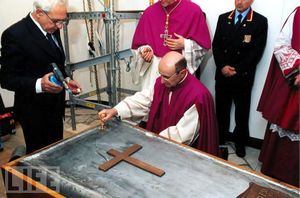 The Holy See is allowing the coffin of Pope John Paul II to be viewed following the May 1st beatification ceremony which will be celebrated by Pope Benedict XVI.
The Holy See is allowing the coffin of Pope John Paul II to be viewed following the May 1st beatification ceremony which will be celebrated by Pope Benedict XVI.
Beatification ceremonies for John Paul II are FREE
The Prefecture of the Papal Household, having been
informed of the existence of unauthorised offers by some Tour Operators,
especially on internet, of assistance in procuring tickets, with a service
charge, for General Audiences and Papal ceremonies, particularly for the
Beatification of the Servant of God John Paul II on Sunday, May 1, wishes to
make it clear that:
clear from the outset, no tickets are required.
Prefecture of the Papal Household for General Audiences and Papal ceremonies
are always issued FREE of charge and no person or organization can request any
kind of payment.
Mass of Thanksgiving for the Beatification of Pope John Paul II set for St Catherine of Siena Church, NYC on May 1
John Paul II matters
In the hours before and after the Holy See’s announcement that the famous Pope John Paul II would be beatified on May1st, lists of reasons John Paul matters have shown up. Dan Gilgoff of the Belief Blog at CNN has a list that in my mind is too thin to get excited about. Numbers 1 and 9 on his list, for example, bear neither weight nor content. There’s Rome Reports’ review of John Paul’s astonishing record and how he changed history. John Allen’s analysis is worthy of our consideration because of the context Allen frames for us.
Benedict XVI to beatify John Paul II
Rite of Beatification of John Henry Newman
Many Catholics and Christians of good will are genuinely interested in the formula the Church uses to beatify someone, thus identifying a person a “blessed.” Notice who does/says what in the formula. The following is the rite (with a brief biography) used today by Pope Benedict XVI:
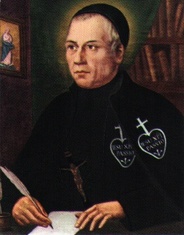 John Henry Newman was born in London in 1801. He was for over twenty years an Anglican clergyman and Fellow of Oriel College, Oxford. As a preacher, theologian and leader of the Oxford Movement, he was a prominent figure in the Church of England. His studies of the early Church drew him progressively towards full communion with the Catholic Church. With his companions he withdrew to a life of study and prayer at Littlemore outside Oxford where in 1845 Blessed Dominic Barberi, a Passionist priest, received him into the Catholic Church.
John Henry Newman was born in London in 1801. He was for over twenty years an Anglican clergyman and Fellow of Oriel College, Oxford. As a preacher, theologian and leader of the Oxford Movement, he was a prominent figure in the Church of England. His studies of the early Church drew him progressively towards full communion with the Catholic Church. With his companions he withdrew to a life of study and prayer at Littlemore outside Oxford where in 1845 Blessed Dominic Barberi, a Passionist priest, received him into the Catholic Church.
influential writer on a variety of subjects, including the development of Christian
doctrine, faith and reason, the true nature of conscience, and university education. In 1879 he was created Cardinal by Pope Leo XIII. Praised for his humility, his life of prayer, his unstinting care of souls and contributions to the intellectual life of the Church, he died in the Birmingham Oratory which he had founded on 11 August 1890.
A Reflection on Cardinal Newman’s Beatification
Father Thomas Rosica, CSB, head of Canada’s Salt and Light Television invests us with an excellent sense of who John Henry Cardinal Newman was as a person and as a priest in a video presentation. Watch Father Rosica’s fine introduction to Newman or read the transcript here.

